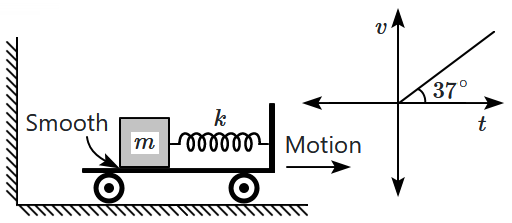The time period of the given spring-mass system is:

1.
\(2\pi \sqrt{\dfrac{m}{k}}\)
2.
\(2\pi \sqrt{\dfrac{m}{2k}}\)
3.
\(2\pi \sqrt{\dfrac{2m}{\sqrt{3}k}}\)
4.
\(\pi \sqrt{\dfrac{m}{k}}\)

The equation of simple harmonic motion is given by X = (4 cm), then maximum velocity of the particle in simple harmonic motion is:
1. 25.12 m/s
2. 25.12 cm/s
3. 12.56 m/s
4. 12.56 cm/s
A spring pendulum is placed on a rotating table. The initial angular velocity of the table is \(\omega_{0}\) and the time period of the pendulum is \(T_{0}.\) If the the angular velocity of the table becomes \(2\omega_{0},\) then the new time period of the pendulum will be:
| 1. | \(2T_{0}\) | 2. | \(T_0\sqrt{2}\) |
| 3. | the same | 4. | \(\dfrac{T_0}{\sqrt{2}}\) |
If the vertical spring-mass system is dipped in a non-viscous liquid, then:
| 1. | Only the mean position changes. |
| 2. | Only the time period changes. |
| 3. | Both the time period and mean position change. |
| 4. | Both the time period and mean position remain the same. |
The displacement \( x\) of a particle varies with time \(t\) as \(x = A sin\left (\frac{2\pi t}{T} +\frac{\pi}{3} \right)\). The time taken by the particle to reach from \(x = \frac{A}{2} \) to \(x = -\frac{A}{2} \) will be:
| 1. | \(\frac{T}{2}\) | 2. | \(\frac{T}{3}\) |
| 3. | \(\frac{T}{12}\) | 4. | \(\frac{T}{6}\) |
Force on a particle \(F\) varies with time \(t\) as shown in the given graph. The displacement \(x\) vs time \(t\) graph corresponding to the force-time graph will be:
| 1. |  |
2. |  |
| 3. |  |
4. |  |
The time period of a simple pendulum in a stationary trolley is \(T_1.\) If the trolley is moving with a constant speed, then the time period is \(T_2.\) Then:
1. \(T_1>T _2\)
2. \(T_1<T _2\)
3. \(T_1=T _2\)
4. \(T_2= \infty \)
1. \(5~\text{Hz}\)
2. \(20~\text{Hz}\)
3. \(10~\text{Hz}\)
4. \(40~\text{Hz}\)
A particle is moving along the x-axis. The speed of particle v varies with position x as . The time period of S.H.M is
1.
2.
3.
4.
A block of mass \(m\) is attached to a massless spring of spring constant \(k,\) with the other end of the spring fixed to the wall of a trolley. Initially, the spring is unstretched, and the trolley begins to move rightward with a velocity that increases linearly with time, as shown in the velocity-time \((v\text-t)\) graph.

The total energy of oscillation of the block as observed from the trolley frame is:
1. \(\dfrac{32m^2}{6k}\)
2. \(\dfrac{9m^2}{8k}\)
3. \(\dfrac{9m^2}{32k}\)
4. \(\dfrac{8m^2}{9k}\)

